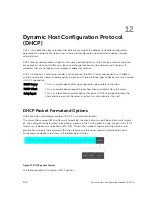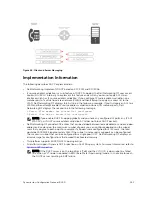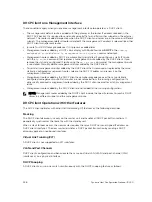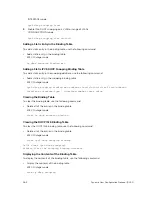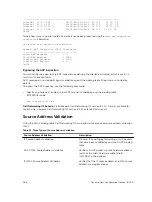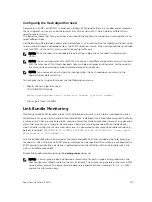
To view the
ip helper-address
configuration for an interface, use the
show ip interface
command from EXEC privilege mode.
Example of the
show ip interface
Command
R1_E600#show ip int tengigabitethernet 1/3
TenGigabitEthernet 1/3 is up, line protocol is down
Internet address is 10.11.0.1/24
Broadcast address is 10.11.0.255
Address determined by user input
IP MTU is 1500 bytes
Helper address is 192.168.0.1
192.168.0.2
Directed broadcast forwarding is disabled
Proxy ARP is enabled
Split Horizon is enabled
Poison Reverse is disabled
ICMP redirects are not sent
ICMP unreachables are not sent
Configure the System to be a DHCP Client
A DHCP client is a network device that requests an IP address and configuration parameters from a DHCP
server.
Implement the DHCP client functionality as follows:
• The switch can obtain a dynamically assigned IP address from a DHCP server. A start-up configuration
is not received. Use bare metal provisioning (BMP) to receive configuration parameters (Dell
Networking OS version and a configuration file). BMP is enabled as a factory-default setting on a
switch.
A switch cannot operate with BMP and as a DHCP client simultaneously. To disable BMP in EXEC
mode, use the
stop bmp
command. After BMP stops, the switch acts as a DHCP client.
• Acquire a dynamic IP address from a DHCP client is for a limited period or until the client releases the
address.
• A DHCP server manages and assigns IP addresses to clients from an address pool stored on the
server. For more information, refer to
Configuring the Server for Automatic Address Allocation.
• Dynamically assigned IP addresses are supported only on Ethernet interfaces: 10Gigabit, 40 Gigabit,
and 100/1000/10000 Ethernet Interfaces. The DHCP client is supported on VLAN and port-channel
interfaces.
• The public out-of-band management interface and default VLAN 1 are configured by default as a
DHCP client to acquire a dynamic IP address from a DHCP server.
• By default, the switch is configured to operate in Jumpstart mode as a DHCP client that sends DHCP
requests to a DHCP server to retrieve configuration information (IP address, boot-image filename, and
configuration file). All ports and management interfaces are brought up in Layer 3 mode and pre-
configured with
no shutdown
and
no ip address
. For this reason, you cannot enter configuration
commands to set up the switch. To interrupt a Jumpstart process, prevent a loop from occurring, and
apply the FTOS image and startup configuration stored in the local flash, enter the stop jump-start
command from the console. To reconfigure the switch so that it boots up in normal mode using the
FTOS image and startup configuration file in local flash, enter the reload-type normal-reload
command and save it to the startup configuration:
FTOS# reload-type normal-reload
FTOS# write memory
FTOS# reload
• To re-enable Jumpstart mode for the next reload, enter the
reload-type jump-start
command.
Dynamic Host Configuration Protocol (DHCP)
257
Summary of Contents for Z9000
Page 1: ...Dell Configuration Guide for the Z9000 System 9 7 0 0 ...
Page 80: ...grub reboot 80 Management ...
Page 128: ... 0 Te 1 1 Te 1 2 rx Flow N A N A 128 Access Control Lists ACLs ...
Page 491: ...Figure 70 Configuring OSPF and BGP for MSDP Multicast Source Discovery Protocol MSDP 491 ...
Page 496: ...Figure 73 MSDP Default Peer Scenario 1 496 Multicast Source Discovery Protocol MSDP ...
Page 497: ...Figure 74 MSDP Default Peer Scenario 2 Multicast Source Discovery Protocol MSDP 497 ...
Page 498: ...Figure 75 MSDP Default Peer Scenario 3 498 Multicast Source Discovery Protocol MSDP ...
Page 760: ...Figure 100 Single and Double Tag TPID Match 760 Service Provider Bridging ...
Page 761: ...Figure 101 Single and Double Tag First byte TPID Match Service Provider Bridging 761 ...






